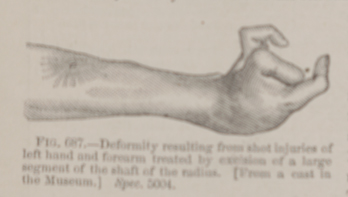Title: Collett, J. R.
Source text: The Medical and Surgical History of the War of the Rebellion. (1861-65.), Part 2, Volume 2 (Washington, DC: Government Printing Office, 1876), 939.
Civil War Washington ID: med.d2e30821
TEI/XML: med.d2e30821.xml
CASE 1896.—Private J. R. Collett, Co. B, 7th Kentucky, aged 18 years, was wounded and captured at Richmond, August 30, 1862. Having been paroled by the enemy immediately after the battle, he remained in hospital at Richmond for about two months, and was then allowed to proceed to his home, where he was treated for a time by a private physician. He subsequently rejoined his regiment, and was discharged from service March 16, 1864, because of "the effects of a gunshot wound which entirely destroyed the use of his left hand, his right arm also being injured." Examiner E. J. Vaughan, of Louisville, July 21, 1865, certified: "A part of an exploded shell struck the left hand in the palm and passed back and up, severing and fracturing the metacarpal bones of the middle and ring fingers, and fracturing both the radius and ulna up to the upper end of the middle third. The right elbow joint is partially anchylosed from the wound by the fragment of shell and his gun striking it, and cannot be flexed. The hand is not only useless, but it is in the way, and will have to be amputated." Examiner W. W. Potter of Washington, D. C., reported, May 14, 1869: "Has received a gunshot wound of the left forearm, fracturing the radius and ulna through the shafts, a large number of pieces having been removed. The carpus has sustained extensive injury and a portion appears to have been removed. The extensor tendons are contracted, completely and permanently extending that portion of the hand remaining. The second and third fingers were carried away at the time of the injury, and the thumb with the first and fourth fingers are flexed, thus leaving a deformed and shapeless hand. The other injury was a fracture between the condyles of the right humerus. The olecranon process of the ulna has forced itself upward into the fracture. Union taking place in this condition leaves the joint partially anchylosed; flexion cannot be carried to a right angle, nor extension completely performed." The pensioner has been for some years employed at the Treasury Department. In March, 1868, he visited the Museum, where a cast of his left arm (FIG. 687) was obtained. According to the pensioner, Surgeon W. Berry, 7th Kentucky, excised the greater portion of the shaft of the radius on the third day after the injury. The pensioner was paid September 4, 1875.
